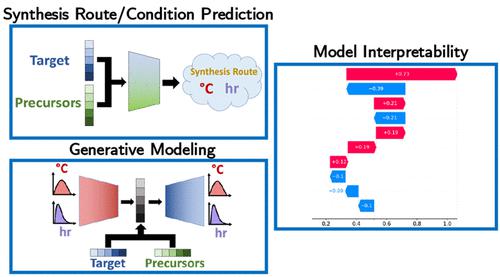当前位置:
X-MOL 学术
›
Chem. Mater.
›
论文详情
Our official English website, www.x-mol.net, welcomes your feedback! (Note: you will need to create a separate account there.)
Interpretable Machine Learning Enabled Inorganic Reaction Classification and Synthesis Condition Prediction
Chemistry of Materials ( IF 8.6 ) Pub Date : 2023-01-27 , DOI: 10.1021/acs.chemmater.2c03010 Christopher Karpovich 1 , Elton Pan 1 , Zach Jensen 1 , Elsa Olivetti 1
Chemistry of Materials ( IF 8.6 ) Pub Date : 2023-01-27 , DOI: 10.1021/acs.chemmater.2c03010 Christopher Karpovich 1 , Elton Pan 1 , Zach Jensen 1 , Elsa Olivetti 1
Affiliation

|
Data-driven synthesis planning with machine learning is a key step in the design and discovery of novel inorganic compounds with desirable properties. Inorganic materials synthesis is often guided by heuristics and chemists’ prior knowledge and experience, built upon experimental trial-and-error that can be both time and resource consuming. Recent developments in natural language processing have enabled large-scale text mining of scientific literature, providing open-source databases of synthesis information on realized compounds, material precursors, and reaction conditions (temperatures, times). We employ supervised classification machine learning (ML) models to distinguish between solid-state, sol–gel, and solution (hydrothermal, precipitation) synthesis routes based on specified reaction target material and/or precursor materials. We demonstrate regression ML models that are able to predict suitable temperatures and times for the crucial inorganic synthesis steps of calcination and sintering given the reaction target and precursor materials. We contrast this regression-based condition modeling with a conditional variational autoencoder neural network that can generate appropriate distributions for the synthesis conditions of interest. We evaluate model interpretability using the Shapley additive explanations approach to gain insight into factors influencing suitability of synthesis route and reaction conditions. We find that the aforementioned models are capable of learning subtle differences in target material composition, precursor compound identities, and choice of synthesis route that are present in the inorganic synthesis space. Moreover, they generalize well to unseen chemical entities, outperform common heuristics in the field, and show promise for predicting appropriate reaction routes and conditions for previously unsynthesized compounds of interest.
中文翻译:

可解释的机器学习支持无机反应分类和合成条件预测
数据驱动的机器学习合成计划是设计和发现具有理想特性的新型无机化合物的关键步骤。无机材料合成通常以启发式方法和化学家的先验知识和经验为指导,建立在可能既耗时又耗资源的实验反复试验的基础上。自然语言处理的最新发展使科学文献的大规模文本挖掘成为可能,提供了关于已实现化合物、材料前体和反应条件(温度、时间)的合成信息的开源数据库。我们采用监督分类机器学习 (ML) 模型根据指定的反应目标材料和/或前体材料区分固态、溶胶-凝胶和溶液(水热、沉淀)合成路线。我们展示了回归 ML 模型,该模型能够在给定反应目标和前体材料的情况下,预测煅烧和烧结等关键无机合成步骤的合适温度和时间。我们将这种基于回归的条件建模与条件变分自动编码器神经网络进行对比,后者可以为感兴趣的合成条件生成适当的分布。我们使用 Shapley 加法解释方法评估模型的可解释性,以深入了解影响合成路线和反应条件适用性的因素。我们发现上述模型能够学习无机合成空间中存在的目标材料组成、前体化合物特性和合成路线选择方面的细微差异。而且,
更新日期:2023-01-27
中文翻译:

可解释的机器学习支持无机反应分类和合成条件预测
数据驱动的机器学习合成计划是设计和发现具有理想特性的新型无机化合物的关键步骤。无机材料合成通常以启发式方法和化学家的先验知识和经验为指导,建立在可能既耗时又耗资源的实验反复试验的基础上。自然语言处理的最新发展使科学文献的大规模文本挖掘成为可能,提供了关于已实现化合物、材料前体和反应条件(温度、时间)的合成信息的开源数据库。我们采用监督分类机器学习 (ML) 模型根据指定的反应目标材料和/或前体材料区分固态、溶胶-凝胶和溶液(水热、沉淀)合成路线。我们展示了回归 ML 模型,该模型能够在给定反应目标和前体材料的情况下,预测煅烧和烧结等关键无机合成步骤的合适温度和时间。我们将这种基于回归的条件建模与条件变分自动编码器神经网络进行对比,后者可以为感兴趣的合成条件生成适当的分布。我们使用 Shapley 加法解释方法评估模型的可解释性,以深入了解影响合成路线和反应条件适用性的因素。我们发现上述模型能够学习无机合成空间中存在的目标材料组成、前体化合物特性和合成路线选择方面的细微差异。而且,


























 京公网安备 11010802027423号
京公网安备 11010802027423号